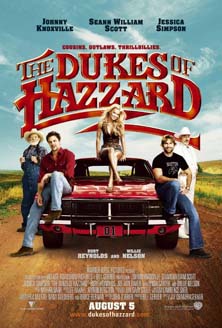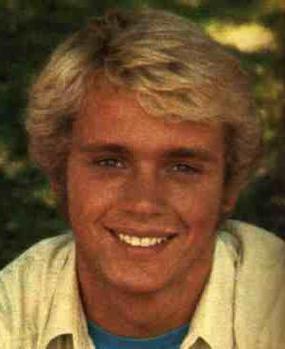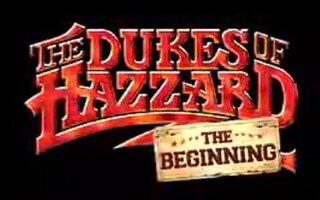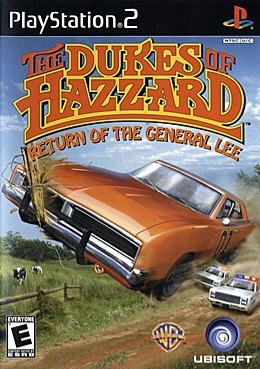
The Dukes of Hazzard is an American action comedy television series created by Gy Waldron that aired on CBS from January 26, 1979, to February 8, 1985, with a total of seven seasons consisting of 147 episodes. It was consistently among the top-rated television series in the late 1970s and early 1980s.

The Dukes is a 30-minute Saturday morning animated series based on the live-action television series The Dukes of Hazzard which aired on CBS from February 5 to October 29, 1983. Hanna-Barbera Productions produced the series in association with Warner Bros. Television, producer of the original series. 20 episodes were produced.

Daisy Duke is a fictional character, played by Catherine Bach, from the American television series The Dukes of Hazzard. She is the cousin of Bo and Luke, the protagonists of the show, and the three live on a farm on the outskirts of Hazzard County with their Uncle Jesse.

The Dukes of Hazzard is a 2005 American action comedy film loosely based on the television series of the same name. The film was directed by Jay Chandrasekhar and released on August 5, 2005, by Warner Bros. Pictures. As in the television series, the film depicts the adventures of cousins Bo, Luke, and Daisy, and their Uncle Jesse, as they outfox crooked Hazzard County Commissioner Boss Hogg and Sheriff Rosco P. Coltrane.

Cruis'n Exotica is a 1999 racing game developed for arcades by Midway Games. The game is a sequel to Cruis'n World and is the third entry in the Cruis'n series.

Enos is an American action comedy television series and a spin-off of The Dukes of Hazzard. It originally aired on CBS from November 12, 1980, to May 20, 1981. The series focused on the adventures of Enos Strate, a former deputy in rural Hazzard County, after he moved to Los Angeles to join the LAPD. Sonny Shroyer played the character of Enos on both shows. The scene was set for Enos leaving Hazzard to become a Los Angeles lawman in the third season Dukes of Hazzard episode "Enos Strate To The Top".
Jefferson Davis "J.D." Hogg, known as Boss Hogg, is a fictional character featured in the American television series The Dukes of Hazzard. He was the commissioner of Hazzard County, and the county's political boss. Boss Hogg almost always wore an all-white suit with a white cowboy hat and regularly smoked cigars. He is the namesake of Jefferson Davis, the President of the Confederate States of America. The role of Boss Hogg was played by Sorrell Booke, who performed frequently on radio, stage, television, and film prior to his role in The Dukes of Hazzard. The character was played by Burt Reynolds in the 2005 film.

Beauregard "Bo" Duke is a fictional character in the American television series The Dukes of Hazzard, which ran from 1979 to 1985. He was played by John Schneider.

Lucas K. "Luke" Duke is a fictional character in The Dukes of Hazzard, an American comedy television series which ran from 1979 to 1985. Played by Tom Wopat in the original TV series, Luke is the dark-haired, older cousin to the character Bo Duke. He is often the one who comes up with plans to get the Duke family out of trouble. He performs more of the physical stunts, while his cousin Bo does most of the driving. Both Duke boys are known for their signature "hood slide" across the General Lee, their 1969 Dodge Charger. Luke acted hypocritically on occasion, most prominently in season 1 episode 6 "Swamp Molly".

The Dukes of Hazzard: Reunion! is a 1997 American made-for-television action-adventure film, reuniting the surviving cast members of the 1979–1985 television series The Dukes of Hazzard, which originally aired on CBS on April 25, 1997. The film was directed by Lewis Teague, written by series creator Gy Waldron, and produced by Ira Marvin and Skip Ward.

The Dukes of Hazzard: The Beginning is a 2007 American made-for-television buddy comedy film and a prequel to the 2005 film The Dukes of Hazzard. An edited version of the film originally aired on ABC Family channel on March 4, 2007, and the 'R'-rated and unrated versions were released on DVD March 13.
The Dukes of Hazzard: Hazzard in Hollywood is a 2000 American made-for-television action-adventure comedy film based on the 1979–1985 television series The Dukes of Hazzard which aired on CBS on May 19, 2000.

The Dukes of Hazzard is a 1984 racing video game developed and published by Coleco for their ColecoVision game console and Coleco Adam computer. Elite Systems released a different game with the same title for the ZX Spectrum computer on February 23, 1985. Both versions are based on the television series of the same name.

Toy Story Racer is a 2001 kart racing game developed by Traveller's Tales and Tiertex Design Studios and published by Activision. It was based on the Toy Story franchise, primarily the first film. The game was released in March 2001 for the Game Boy Color and PlayStation systems. The PlayStation version received "generally favorable reviews" according to Metacritic. In 2010, the PlayStation version was re-released on the PlayStation Store as a PS one Classic.

The Dukes of Hazzard: Racing for Home is a racing video game published by SouthPeak Interactive that was released for the PlayStation in 1999. The game was later released for Game Boy Color and Microsoft Windows in 2000. It is based on the television show, The Dukes of Hazzard. Waylon Jennings, James Best, Ben Jones, Sonny Shroyer, and Tom Wopat reprised their characters by providing their voices to the PC and PlayStation versions of the game. A sequel titled The Dukes of Hazzard II: Daisy Dukes It Out was released in 2000.

The Dukes of Hazzard: Return of the General Lee is a racing video game developed by Ratbag Games and published by Ubisoft. It was released in 2004 for the PlayStation 2 and Xbox consoles. The game is based on the television series The Dukes of Hazzard and was released to coincide with The Dukes of Hazzard film, which was released in 2005.
Rosco Purvis Coltrane is a fictional sheriff character who first appeared in the 1975 film Moonrunners, which inspired the creation of the American TV series The Dukes of Hazzard.

Hazard Run is a 1982 racing video game developed by Dennis R. Zander and published by Artworx for Atari 8-bit computers. In 1984, Artworx considered re-publishing the game as a tie-in to the television series The Dukes of Hazzard.

Hot Wheels Ultimate Racing is a 2007 racing video game developed by Italian company Raylight Studios and published by DSI Games for the PlayStation Portable (PSP) exclusively. The game is based on the Hot Wheels toy line which manufactured by Mattel.















